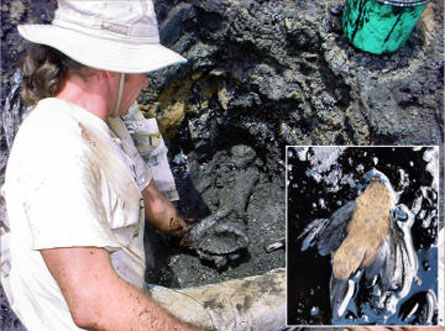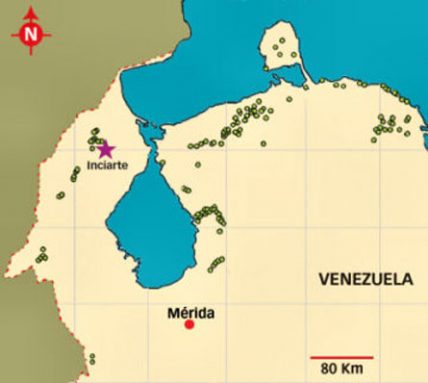South America's sticky tar pits
 |
| The menes of Venezuela take claimed many lives, observable in that 25,000-year-old fossil plant near Inciarte and the more recent remains of a songbird found at Orocual (inset). |
| Rincón |
Los Angeles' Rancho Atomic number 57 Brea is one of the world's all but famous fossil-bearing sites. Its tar pits, or sticky pools of asphalt, have yielded much 1 million fossils. They include 50 mammalian species, 125 types of birds, and dozens of reptiles, insects and other invertebrates. But L.A.'s claim to fossil fame could someday soon be equaled or surpassed by tar pits far south of the U.S. perimeter.
Hundreds of oil seeps, also called menes, dot the landscape in Venezuela. They are thousands of miles from Rancho La Brea. Explorers have known about these sites, which trap animals with their stickiness, for more than 400 years. But paleontologists give birth merely just begun to conduct sobering domiciliation in that location in the other 10 years more or less.
These South North American country sites are all-important for several reasons. First, the South American nation menes are found in a variety of ecosystems, scientists note. Indeed their sediments may hold more types of creatures. Second, these sites are located just about to where the Band of Panama joins Septentrion America with South America. So fossils in the menes hold may clear up the migrations of creatures to and from South America.
Excavations at one mene site intimate that its oil-ample sediments — and the creatures that they've trapped — accumulated over a much longer period of time than those at Rancho La Brea. Thus fossils entombed at this menes sight power yield insights into how and when climate changed as Earth slipped in and out of Recent epoch methamphetamine hydrochloride ages.
Sticking points
Tar pits form where crude oil from petroleum-rich strata, or rock layers, moves through cracks in superimposed strata to Earth's aboveground. The ignitor components of that oil quickly vaporize. This leaves behind a slime rich in mineral pitch (the same stuff accustomed pave roads). That asphalt can mire even the strongest creature. In blue South America, tar pits can represent found in a swath that stretches from the eastern coast of Venezuela to Peru and Ecuador, says David M. Orchard. He's a geologist with the oil company ConocoPhillips in Houston.
To that extent, very few of these menes have yielded fossils or been studied in depth, says Orchard. In the 1950s, Canadian researchers excavated fossils at Peru's Talara site and Ecuador's La Carolina site. At both of these locations, scientists found many fossils of birds. They too found canids, a group of mammals that includes dogs, wolves and foxes.
Now, however, scientists are very excited about fossils base in a tar endocarp good Inciarte. This is in northwestern Venezuela. That mene, more than 1 km extended and 500 meters bird's-eye, is at least 10 times the size of it of any of the pitch pits at L.A.'s Rancho La Brea, says Orchard.
Despite this king-size sized, scientists have removed only about 1.5 cubical meters of sediment, or around 15 garden cart loads, from the land site. From this material, Orchard and his colleagues already have identified the remains of more than than 100 species. These include 43 mammals, 56 birds, 11 lizards and 4 frogs. That species tally renders Inciarte the most fossil-plush place in northern South America.
Plantation and his colleagues have carbon-datable whatever of the Inciarte fossils. And they range between 25,000 and 27,000 years of age. That means they came from a few millennia before the height of the last glacial period.
The Inciarte excavations have produced several revelations about the region's ancient canids. Researchers rich person identified fragments of a skull as Urocyon cinereoargenteus, the Urocyon cinereoargenteus, a North American species never before rumored to live in South America. Also, teeth and jaw fragments of an extinct species illustrious as the cave wolf have turned up at Inciarte. This creature is known to have lived only in Southwesterly America and previously was found alone at sites at least 1,500 klick farther south of Inciarte.
"At Inciarte, there's a commingling [mixing] of what are typically thought of as North American and Southward American species," says Christopher A. Shaw. He is a vertebrate paleontologist at the Natural History Museum of Los Angeles County. At the South American site, the ground sloths, camels and other species characteristic of old South America lived alongside the dire wolves and sabre-toothed cats typically related with Rancho La Brea and other N American sites.
"We know a lot most the species in North Dry land and in Argentina," says Ascanio D. Rincón, a palaeontologist at the Venezuelan Bring of Scientific Investigations in Caracas. "In the middle, we jazz all but nothing about what happened."
Riches of eastern Venezuela
Like the field near Inciarte in northwestern Venezuela, the Maturín Basin in the eastern part of the country is dotted with scores of menes. In 2006, workers digging a line there unexpectedly began to excavate oil-rich sediments that were chock-full of bones. Although the fieldwork at the site, dubbed Altitude Breal de Orocual, was rushed and wasn't as systematic as it could deliver been, wee results are promising.
Paleontologists have in so far identified the fossils of more than two twelve species, says Rincón. The presence of amphibious creatures such as caimans and tapirs suggests that the surface area once was a flood plain or river delta, he notes. However, the remains of creatures such as llamas and glyptodonts — armored armadillos, some species of which grew to the size and weight of Volkswagen Beetles — hint that the area also hosted a savannah. In all probability, says Rincón, the mene sat in a swampy area where water helped disguise the pestilent Jack-tar. Analyses of the Orocual sediments suggest that they were deposited between 1 million and 500,000 years agone.
Orocual "is the first area I've seen that sack challenger Rancho Lah Brea," says Artie Shaw, the L.A.-based fossilist. "The preservation is just wonderful down there, and it's amazing how well even delicate things like centipedes throw been kept up." Considering the extent of the site, Shaw speculates that it could easily yield hundreds of thousands of fossils.
Although each tar pit English hawthorn be active for only a few thousand long time, just a small sampling of the immense number of menes in Venezuela could provide paleontologists with a fossil record for the region that could unfold back Thomas More than 2 trillion years. In contrast, the dodo commemorate at L.A.'s Rancho La Brea stretches plump for only 40,000 years close to.
"The combination of that long time range and the diversity of ecosystems that could be represented in these menes," Orchard says, "is an extraordinary opportunity for science."
"The Inciarte site is then rich, in that location's more [palaeontology] than anyone pot do in a life-time," says McDonald. "We're merely now offse a very long and real breathtaking process."


0 Response to "South America's sticky tar pits"
Post a Comment